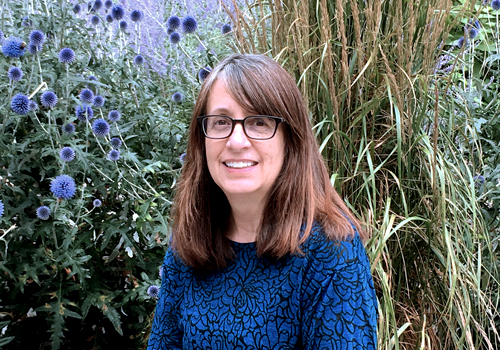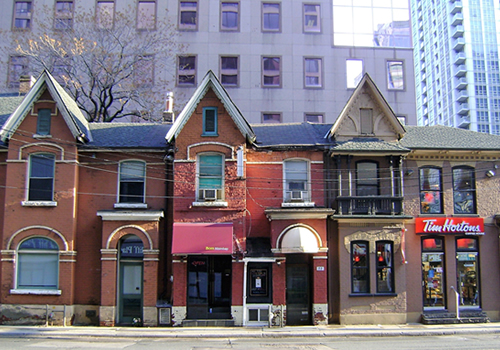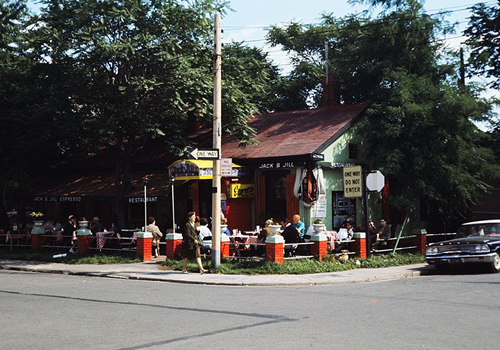At the southeast corner of the University of Toronto campus are a few blocks that boast an interesting cultural history of the city — what was once known as our very own Greenwich Village — but you wouldn’t know it from walking the streets today.
The former village used to be on Gerrard Street West, between Bay and Elizabeth streets. Pre-1950, the village hosted painters like Arthur Lismer, Albert Franck, Franz Johnson and studio artisans such as metal workers Nancy Meek (later to become Nancy Pocock) and Rudy Renzius. Writer Morley Callaghan could be found there as well as sculptors Eugenia Berlin and Pauline Redsell. Later, the abstract-expressionist Painters Eleven group got its start with artists like Ray Mead, Kazuo Nakamura and Harold Town hanging out at the home of Albert Franck and Florence Vale.
Today, it’s a row of old brick houses that include a Tim Hortons, Jimmy’s Coffee and other small restaurants. Surrounded by office buildings, apartments and a big parking lot, that row of seven old houses is all that’s left of the place where poets and artists came to hang out at galleries and readings in the 1950s and 1960s.
Where poets and artists came to hang out in the 1950s and 1960s
It’s also where Professor Heather Murray of English started her research. She was hoping to dig up information on some of Toronto’s forgotten arts and literary history; instead found much more about what the neighbourhood was like before the artists moved in. Murray hopes to publish a book eventually focusing on the history of the village before 1950.

The neighbourhood in our downtown core — what was once called The Ward — was a landing ground for immigrants beginning in the 1850s. They resided in tenements — multiple families to one house, often without floors or plumbing. The area was described as rough, but also vibrant, with many cultures.
In 1930, the Eatons opened their College Street store — where College Park is today— and many retail boutiques followed, turning houses into stores, and changing the neighbourhood significantly. When the Depression hit, many stores couldn’t afford to stay, so in came the artisans — weavers, jewellery makers, metalworkers – who could fill spaces together.
Toronto is no stranger to gentrification — changes in Kensington Market, Parkdale, and the recent closure of Mirvish Village are current examples — but Murray hopes to draw attention to what happens to communities when their homes are taken away from them.
Scouring the archives for clues

“I’m interested in what happens when people get pushed out of an area,” says Murray. “The area was quite demographically mixed, but as soon as you start moving in shops, the rents go up, and you’re starting to push out populations. I don’t want to only tell a story of an art community, I want to tell the story of the neighbourhood.”
Murray’s biggest challenge is trying to piece together the story of an area that’s over 80-years-old. For the past couple years, Murray has been making her way through archives, looking for clues.
At York University’s archives, she found the personal papers of late peace activist Nancy Pocock, who owned a jewellery and pottery studio in the village in the 1930s. Looking through issues of the 1920s drama magazine Curtain Call has revealed what shops and studios took out advertisements. Through Toronto Public Library and City of Toronto archives, she’s found names of artists who lived in the area. Often the people she meets are a great source of information. At a recent Congress of Humanities and Social Sciences conference, she encountered a woman who had lived in a hospital residence in the area in the 1950s, another whose father had been a local jazz musician and someone whose family once owned a restaurant there.
This is a little out of my normal century

All of this investigative work has been a thrill for Murray, who was working on a history of reading and nationalism in Canada in the 19th century before this story took hold of her attention.
“This is a little out of my normal century,” she says. ‘This is not what I was intending to do next, but it’s just come to the front. I’m having a lot of fun with it. I love doing a Toronto project and I want to tell the story of an area, especially in its earlier decades, that has almost been completely forgotten because there’s nothing to remember it by anymore.”

